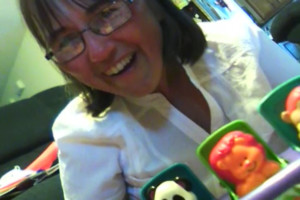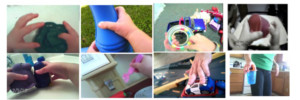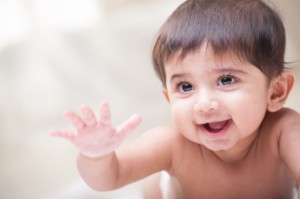A conversation with Dr. Linda Smith – Bringing Head Cameras Home
What is learning? What does it mean to learn? WonderLab intern Aditya Belamkar sat down with Distinguished Professor and Chancellor’s Professor of Psychological and Brain Sciences Dr. Linda Smith, who provided some insight into the mysterious brains of our tiniest scientists.
Background – Psychologists have been attempting to explain what it means to learn since the mid-1800s. From Ivan Pavlov and his salivating dogs to Indiana University’s very own B.F. Skinner, there have been several models that strive to describe this vast concept of learning. Additionally, children are notoriously fast learners, picking up a new language in just a few years. Once they see and touch an object, they are able to make categories that new objects can either be placed into or compared against. The study of cognitive development is all about discovering how a babbling child eventually grows into a doctor, a CEO, a chef, a musician, a teacher, an athlete, an electrician, or a cyber-security expert. The question of what happens during childhood that allows these amazing changes to occur is one that psychologists continue to pursue.
Dr. Linda Smith, who was the winner of the 2019 Norman Anderson Lifetime Achievement Award from the Society of Experimental Psychologists, one of the most distinguished societies of psychology, has been exploring how children learn for over 40 years. Her research career has been focused on the fields of cognitive science and developmental psychology, with a particular emphasis on how children break into language.
Developmental Research and Infants – “Now, I think developmental research
is the only way to do any kind of psychology,” Smith said. “How did it get built? What are the inflection points? Where did things go wrong, and how can you make them right? What is the pathway that turned each of us into who we are, and makes some of us successful while others falter? How can we work around those obstacles?”
According to Smith, typical lab-based research involving babies does not properly replicate the home environment, as scientists have previously thought.
“A lot of the ideas we had about children’s learning environments are wrong.” Smith said. “So for example, experimental psychologists have often gone and brought babies into labs and asked parents to play with them. I’ve done this too, at a table with toys, and we think we’re simulating the natural world with the language input and how parents interact with their children. But when you go into the home, parents do that, 20 minutes a day max. They’ve got to do laundry. They’re talking to their kids, they’re jabbering away, but not in that context. The data for learning doesn’t look like what we think it looks like.”

Infant head camera views. Lab Images courtesy of Dr. Linda Smith’s Cognitive Development Lab at Indiana University.
Introducing the Head Camera –Smith said that most current knowledge of child development comes from simulated laboratory studies that attempt to simulate a natural environment, but this may not be possible. Her lab is attempting to understand the natural statistics that describe object-name learning using data derived from her new research tool: head cameras. Smith has been placing caps containing head cameras on babies from the ages of two months to two years in order to obtain a first-person view and experience of the child’s development in a constantly changing world.
The home provides a much more natural world that may provide varying conclusions from those derived from laboratory simulations. Smith has been able to collect over a million images and over 500 hours of video from the head cameras. Now, Smith said, the team is attempting to decipher the statistical structure of the data. Her team is asking questions: “What’s the frequency distribution of instances of categories, objects, the words parents say, and tracking how those environments change with development?”

Infant head camera views. Lab Images courtesy of Dr. Linda Smith’s Cognitive Development Lab at Indiana University.
Smith’s head camera research began due to her interest in development associated with babies playing with objects, but the data provided provides much more interesting conclusions that seem to bring past findings into question.
Conclusions – Smith believes that this novel method of looking at child development has the ability to revolutionize the field. According to Smith, learning models have always been of utmost importance and interest within psychology. The ability for children to pick up a language within a few years of birth is an amazing skill that researchers are still attempting to understand, describe and – in the case of artificial intelligence – replicate. Learning has come so far from bells and salivating dogs, but the field also has so much further to go, and the utilization of head cameras in the home has the potential to drive this evolution.
About Dr. Linda Smith: Dr. Linda B. Smith is a Distinguished Professor and Chancellor’s Professor in the Department of Psychological and Brain Sciences at Indiana University. Smith earned her Ph.D. from the University of Pennsylvania. Smith is the author of more than 100 publications on cognitive and linguistic development in young children. Dr. Smith will be the featured speaker during WonderLab’s 16th Annual Gala, Science Night Out 2019 Kaleidoscope: Fractals, Tessellations, & the Beauty of Math.




Leave A Comment